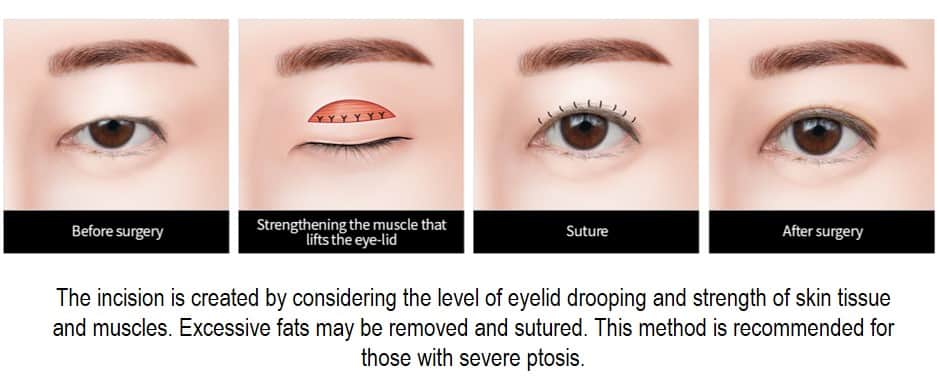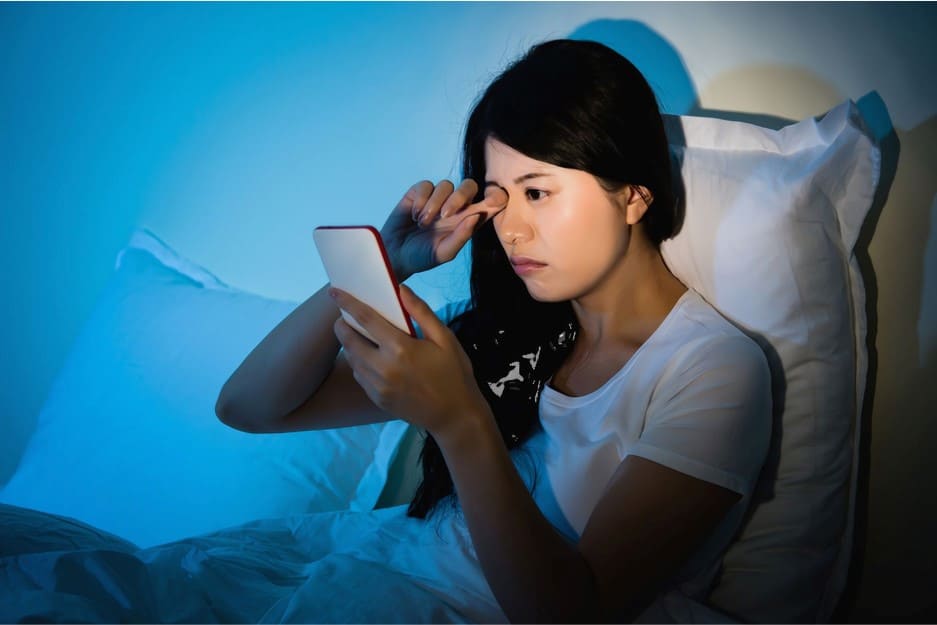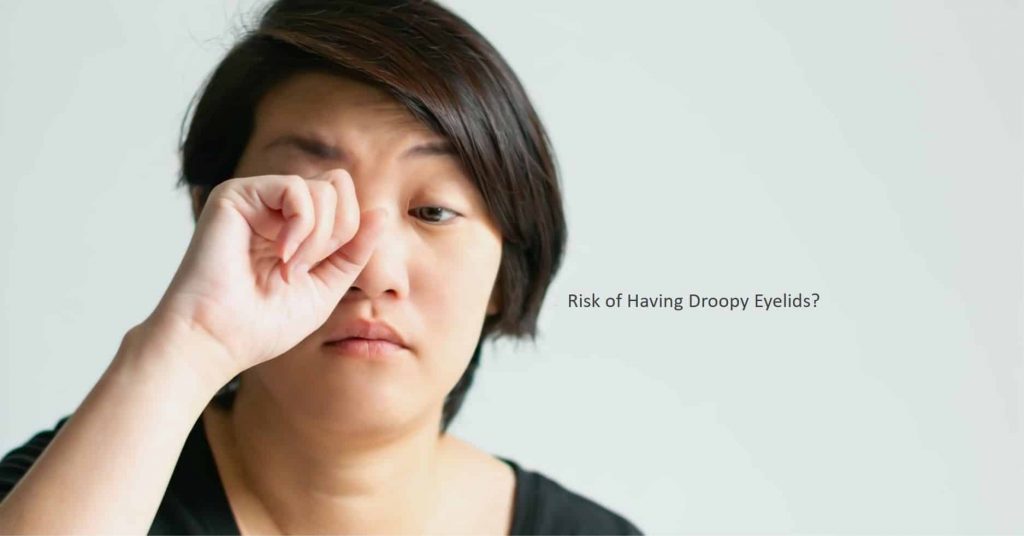Also called ptosis or blepharoptosis, the drooping eyelid is a condition in which the edges of the upper eyelids drop down to a level lower than normal. It can affect one or both eyes. Although ptosis is equally common in both men and women, it is more prevalent in older adults.
Individuals of all age groups can be affected by droopy eyelids. However, some babies are born with it. While the exact cause can be unknown, it can be acquired or occur due to congenital, trauma or neurological reasons.
The symptoms of ptosis can include sagging of one or both upper eyelids, dry and watery eyes, blurred vision, aches on and around eyes. The drooping of the eyelids might cause some people to look perpetually tired.
Interference with vision becomes really inconvenient in severe cases where the drooping eyelid either covers the pupil partly or entirely. This often forces people to tilt their heads back to see during a conversation.
While some are born with it, others may put themselves at risk of acquiring ptosis. If droopy eyelids are present at birth, they are called congenital ptosis. However, this condition can also develop over time due to poor habits as well as a serious underlying medical condition related to the eyes, muscles, nerves, or brain. Your doctor will investigate and diagnose the exact cause of droopy eyelids and rule out any other medical complications.
This article will discuss the risk factors for ptosis, what can be done if you have droopy eyelids, ptosis correction treatment options, and whether it can be prevented.
What Increases The Risk Of Ptosis
1. Aging

During the process of aging, the weakened levator muscle that lifts the eyelid becomes less responsive and as a result, the eyelid lowers, exposing less of the pupil. Drooping that occurs due to aging is called aponeurotic or senile ptosis.
2. Contact Lenses Wearers
Wearing contact lenses for extended periods can lead to acquired ptosis in the long run. Research has shown that constant stretching and tugging of the eyelid muscles can cause them to wear down faster.
3. Those Who Rub Their Eye Excessively
Excessive rubbing of the eyes or pulling the eyelids can cause droopy eyelids. This occurs due to physical damage to the levator muscle from the rubbing motion.
4. Double Eyelid Tape or Glue Users
 The Korea Times reported that doctors have warned about the prolonged use of double eyelid tape or glue. It states that using double eyelid tape or glue is an effective and quick way to create a crease over the eye. However, it is recommended for occasional use. Regular tugging and pulling associated with the application methods can lead to severe sagging of the upper eyelid.
The Korea Times reported that doctors have warned about the prolonged use of double eyelid tape or glue. It states that using double eyelid tape or glue is an effective and quick way to create a crease over the eye. However, it is recommended for occasional use. Regular tugging and pulling associated with the application methods can lead to severe sagging of the upper eyelid.
5. Eye Surgeries
Droopy eyelids can occur after a surgical procedure, which is referred to as postsurgical ptosis. For example, after cataract surgery, the levator muscle can separate with time leading to droopiness in the eyelids. It has been reported that ptosis can also occur after corneal, refractive (Lasik), or glaucoma surgery.
6. Muscle Problems
There are some disorders that may lead to problems in the eyelid muscles and end up causing droopy eyelids. These include oculopharyngeal muscular dystrophy (OPMD), chronic progressive external ophthalmoplegia (CPEO), and myotonic dystrophy that occurs in adult life. Also, conditions like Myasthenia Gravis weaken the muscles and present ptosis as one of the early symptoms.
Treatments for Ptosis Correction
There are predominantly two ways for droopy eyelid treatment. The choice of ptosis treatment depends upon the severity of your case.
1. Non-Incisional Ptosis Correction
 In the non-incisional ptosis surgery, a portion of the eyelid muscles is tied with the help of a suture to reduce its length. This produces a tightening effect, allowing the eyelid to be raised higher when eyes are opened. This procedure is done in mild to moderate cases and takes about 40-60 minutes to complete. A local anesthetic or light sedation is utilized for the non-incisional procedure. The recovery period is around 7 to 10 days, and suture removal is done 7 days after the procedure. The non-incisional ptosis procedure can be suitable for you if you want minimal swelling, and a faster recovery with the least possible downtime.
In the non-incisional ptosis surgery, a portion of the eyelid muscles is tied with the help of a suture to reduce its length. This produces a tightening effect, allowing the eyelid to be raised higher when eyes are opened. This procedure is done in mild to moderate cases and takes about 40-60 minutes to complete. A local anesthetic or light sedation is utilized for the non-incisional procedure. The recovery period is around 7 to 10 days, and suture removal is done 7 days after the procedure. The non-incisional ptosis procedure can be suitable for you if you want minimal swelling, and a faster recovery with the least possible downtime.
2. Surgical Ptosis Correction
 In moderate to severe cases, incisional ptosis surgery is done. During this procedure, a scalpel is used to make an incision to remove a part of the lengthened muscles in the eyelid, before it is repositioned upwards. This lifts the eyelid higher when eyes are opened. The duration of this procedure is approximately 60-90 minutes. The surgery recovery period is 10-14 days, and suture removal is done seven days after the procedure.
In moderate to severe cases, incisional ptosis surgery is done. During this procedure, a scalpel is used to make an incision to remove a part of the lengthened muscles in the eyelid, before it is repositioned upwards. This lifts the eyelid higher when eyes are opened. The duration of this procedure is approximately 60-90 minutes. The surgery recovery period is 10-14 days, and suture removal is done seven days after the procedure.
Can Droopy Eyelids Be Prevented?
 Whether droopy eyelids can be prevented or not depends on the actual cause. It is difficult to prevent the development of congenital ptosis. Moreover, acquired ptosis may develop in patients due to numerous causes that are hard to also hard to avoid. For example, senile ptosis occurs due to the physiological aging process that weakens the eyelid muscles. Other causes, such as eye trauma, muscle problem, nerve damage, and surgery, can also be challenging to prevent.
Whether droopy eyelids can be prevented or not depends on the actual cause. It is difficult to prevent the development of congenital ptosis. Moreover, acquired ptosis may develop in patients due to numerous causes that are hard to also hard to avoid. For example, senile ptosis occurs due to the physiological aging process that weakens the eyelid muscles. Other causes, such as eye trauma, muscle problem, nerve damage, and surgery, can also be challenging to prevent.
On the other hand, lifestyle and habits such as excessive eye rubbing, eyelid tapes and wearing contact lenses is associated with an increased risk of ptosis. Conclusively, not using contact lenses for extended periods, minimize and tugging on the eyelids and avoiding rubbing eyes excessively can help prevent the development of acquired ptosis.
Categorically, because ptosis can interfere with your vision, it should be taken seriously. Identifying and treating the root cause of ptosis promptly can help prevent the condition from getting any worse. Therefore, visit your healthcare provider immediately if you observe initial signs of ptosis development in your eyes or any of your family members.
Why Is Ptosis A Problem, And How It Can Affect an Individual?
While congenital ptosis has a genetic predisposition and cannot be avoided, it can be a cause of concern. This is because too much sagging of the eyelids can obstruct vision and, thus, impair eyesight. Persistent head-tilt can secondarily produce head and neck pain.
Moreover, ptosis might also depict a more serious underlying health condition, e.g., a neurodegenerative disease. If not addressed promptly, the condition may get complicated later. If a patient suffers from any muscular disorder, it may manifest as ptosis while simultaneously affecting other muscle groups of your body, causing pain and overall weakness. This will result in a lack of energy, reduced confidence, and poor performance.
Acquired ptosis usually develops over a long period of time and may only be noticed when it is more serious. While a more severe case can still cause vision obstruction, motivations for surgical correction are usually due to a combination of functional and aesthetic reasons.
How Can Ptosis Correction Surgery Help Individuals Aesthetically and Functionally?
Functionally, it will allow the patient to get rid of the sagging eyelids and have a clearer and unobstructed vision. It will also help eliminate the secondary problems developed due to ptosis, such as pain and stiffness in the neck due to prolonged head tilt.
Aesthetically, ptosis surgery can immensely improve one’s looks and appearance, increasing the patient’s confidence and quality of life.
When to Consider Ptosis Treatment or Surgery?
It is essential to opt for ptosis correction treatment as soon as it is identified. Delaying droopy eyelid treatment can lead to the progression of the condition from mild to moderate and severe. It can also give rise to secondary symptoms, as already discussed.
If you have a mild case of ptosis, you can consider non-incisional ptosis correction, while for severe ptosis cases, surgical intervention is required.
Always consult a board-certified plastic surgeon. Choosing the right plastic surgeon is important as the final outcome of your procedure depends on the skill and expertise of your professional. A certified surgeon also ensures to minimize the risk of severe swelling or procedural complications.
Dreams Plastic Surgery offers various ptosis correction surgery procedures to meet your needs.
Bottomline
Although droopy eyelids do not generally harm your health, it poses a cosmetic concern for many people. It can cause serious inconvenience and trouble for a lot of people as it may negatively impact their vision.
Your treatment options will primarily depend on the cause of your droopy eyelids and the severity of your condition. Schedule a quick appointment with your healthcare provider to get your condition checked out and rule out any serious underlying medical condition.
About Dream Aesthetics and Plastic Surgery
Bespoke surgical for cosmetic or medical reasons is what Dream covers to bring out the beauty in every individual. Going beyond the aesthetics and working on physical anomalies are what we value the most in leading our patients to cherish self-improvement and confident lifestyles.
Derived from Associate Professor Vincent Yeow’s long-standing experience performing plastic surgery in Singapore, our treatment plans deliver physical remodelling in our patients’ favour. One of the notable remodellings is droopy eyelid correction. The ptosis surgery used for treatment eventually fixes drooping eyelids, improves vision and enhances appearance.
Most importantly, as a trustworthy plastic surgery and aesthetic clinic, we treasure positive and natural outcomes for each individual. We will ensure to deliver the beauty refinement of your dream without compromising your safety and privacy.







